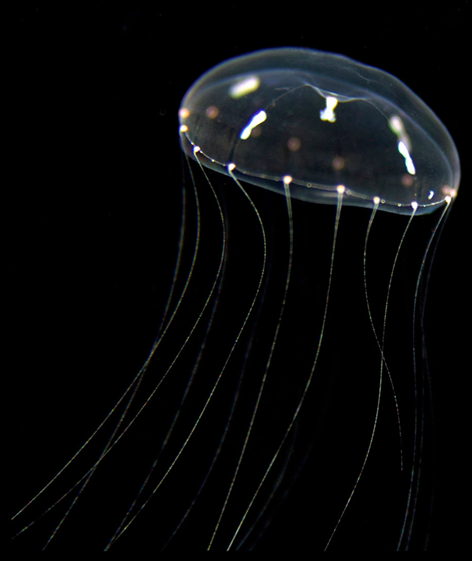Clytia hemisphaerica (jellyfish)

The jellyfish Clytia hemisphaerica is part of a group located outside of the bilaterians, cnidarians, and plays an important role in marine ecosystems. Cnidarians have four classes, including the hydrozoan group to which Clytia belongs. The life cycle of hydrozoans is characterised by the alternation of a polyp phase and a medusa phase.
Expertise d’EMBRC
Access
Easy to raise and handle in the laboratory, all the stages of the life cycle can be cultivated and are available all year round: vegetative propagation of polyps, production of the medusa form by budding, spawning, fertilization and metamorphosis. Several weeks are necessary to anticipate the production of adults or to divide colonies.
Analysis tools
- Fertilisation is external, eggs and embryos are large and transparent, facilitating experiments on these phases and analyses by cell imaging, hybridisation, immunohistochemistry and with fluorescent markers.
- Colonies can be grown easily on glass slides, with indefinite growth, producing a nearly immortal organism.
- Jellyfish spawn every day, exactly two hours after exposure to light following a period of darkness. Eggs and embryos can thus be easily prepared for experiments.
- Reproduction of clonal colonies: the strains that are currently in use have been obtained by intra-strain crosses over several generations, favouring genetic homogeneity, a low level of polymorphism and thus studies of gene function.
- Functional analysis of common genes, micro-injection of eggs with synthetic RNA or morpholinos. Gene inactivation is possible using CRISPR-Cas9 techniques.
- Gene knock-outs using CRISPR-Cas9 techniques has been demonstrated. Mutant strains of Clytia for genes involved in the regulation of embryogenesis are in progress.
- Due to their small size, embryos are suited to pharmacological approaches, to treatments with different types of molecule (chemical agents, natural substances) and require only small quantities.
Scientific advantages of this model organism
- The medusa form of Clytia is planktonic and measures roughly 1 cm in diameter. This stage is sexual. The gametes are released in the water column and fertilisation gives rise to a planula larva that possesses a ciliated ectoderm, undergoes metamorphosis after 3 days and then becomes a primary, sessile polyp. The polyp reproduces by stolons; one of the two polyps produced will replicate by budding new medusae. Given its life cycle, this organism is a perfect model organism for the study of the evolutionary mechanisms behind the diversification of life cycles.
- Clytia is an experimental research model that is particularly useful for the study of fertilisation, regeneration, ecology and physiology.
- Due to its key phylogenetic position, it is a model organism for evolutionary studies, particularly for the evolution of the axes of polarity and germ layers as well as the origin and evolution of the neuro-sensory system and muscles, one of the characteristics of the medusa form which other cnidarians lack, such as the freshwater hydra and the sea anemone Nemastella vectensis. Along with ctenarians, they are the only non-bilaterian animals that have neurons and muscle cells; the medusae can swim and possesses a differentiated nervous system, striated muscles and sensory organs for balance and equilibrium.
- This cnidarian is also a model organism for the study of oogenesis. Other studies are dedicated to the origin of germ cell precursors and those of the somatic cells of gonads; it is also a model for the regeneration of gonads.
- Finally, the presence of multipotent stem cells throughout the whole life cycle of Clytia makes it a model organism for the process of regeneration.
Available genetic resources:
- Collection of some 90,000 ESTs
- Laboratory strains





